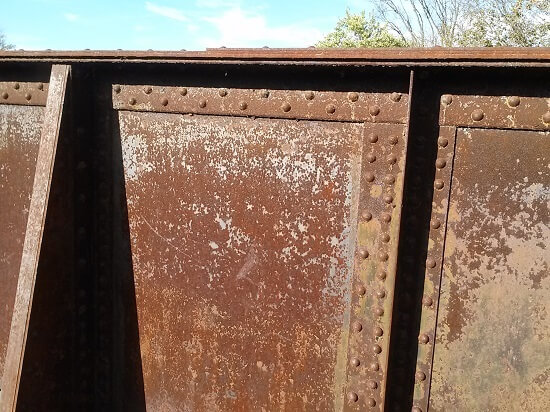Steel is one of the most widely used materials in the construction industry. Its strength and durability give it unmatched versatility that allows it to be used in numerous applications. This material also has a huge market demand, with yearly production costs of about $1.87 billion and healthy projected outputs.
Contrary to popular belief, steel is not a natural metallic element. Rather, it is an alloy of iron and carbon. In other words, it is a mixture of these two independent elements. Even the smallest fluctuation of carbon content can potentially affect the resulting steel’s composition and performance.
Despite its widespread use and popularity, engineers and contractors will benefit from an in-depth knowledge of steel corrosion to ensure that the material is utilized to its full potential. In the remainder of this article we will go through some interesting facts about steel corrosion that everyone working with this material should be aware of.
1. Steel is Not Naturally Corrosion-Resistant
While steel is a proven, durable and efficient construction material, it is not usually selected for its corrosion resistance. The main component of steel, iron, is highly susceptible to corrosion. When exposed to the atmosphere, the iron component of steel reacts with air and moisture to produce:
- Hydrated iron(III) oxides: Fe2O3·nH2O
- Iron(III) oxide-hydroxide: FeO(OH), Fe(OH)3
which are commonly known as rust.
Unlike some metals and alloys whose corrosion products form a natural protective outer layer, rust is brittle and offers no protection. Rust consumes the steel, then flakes off to expose more underlying material. This process continues until the steel component is fully consumed.
Stainless steel is one of the most popular steel alloys. This material is made by combining steel with chromium and small amounts of other metals, such as manganese, silicon, nickel and molybdenum. Chromium, the main component of stainless steel, usually makes up more than 12% of the alloy.
When exposed to the atmosphere, chromium reacts with air and moisture to form a thin, chemically stable, and durable oxide film. This layer protects the stainless steel from further interaction with the atmosphere, thus preventing corrosion. If the oxide film is scratched or damaged, the exposed substrate again reacts with oxygen to restore the film, thus healing itself.
While stainless steel is considered to be corrosion-resistant, it can corrode under very specific conditions in aggressive environments. (For more on this topic, read Why is Stainless Steel Corrosion Resistant?)
3. Steels Do Not Work Well in the Presence of Chlorides
Stainless steel alloys are not suitable for environments with high concentrations of chlorides. Studies show that chlorides negatively affect steel’s ability to form a protective oxide outer layer. Chloride ions in aqueous solutions tend to compete with hydrogen and oxygen during the adsorption process. As a result, passivation is reduced, leading to the formation of pitting, crevice and uniform corrosion. Steels, therefore, are often coated with protective coatings to minimize the harmful effects of chloride-rich environments. Similarly, 316 stainless steel, which exhibits resistance to corrosion in environments with up to 1000 mg/L chloride content, can also be considered for high-chloride applications.
4. Welded Steel Joints are More Likely to be Affected by Corrosion
When stainless steel joints are welded, areas that are vulnerable to corrosion may develop. Austenitic stainless steel, for example, is susceptible to a type of stress corrosion cracking known as active path dissolution. (Find out more in the article 12 Things You Need to Know About Austenitic Stainless Steel.)
During this phenomenon, heat can cause chromium carbides to move away from the grain boundaries. As a result, the grain boundaries become more difficult to passivate due to the reduced chromium content, leading to intergranular corrosion and microcracking. (Related reading: The Role of Chromium in Intergranular Corrosion.) Tensile stresses induced by the cooling of the weld serve to open the cracks further, allowing for easier diffusion of corrosion products away from the tip.
Although the base material for steel is iron, pure iron and uncoated steels do not work well together. During processing, even the smallest amount of residue can affect the corrosion resistance of a stainless steel workpiece. Contamination from plain iron can hamper the formation of stainless steel’s protective oxide layer, compromising its corrosion resistance.
Unlike bimetallic corrosion (which is caused by contact between two dissimilar metals), this type of corrosion can occur even if the two metals are in brief contact with each other. This problem may also arise if iron residue is left on machining tools. Therefore, it is crucial to thoroughly clean all equipment before using it to process stainless steel parts and components.
Despite its appearance, uniform corrosion generally does not indicate imminent failure. Uniform corrosion, also known as general corrosion, is defined as material loss over the entire surface of the material. Unlike pitting, uniform corrosion is not considered to be critical. Deterioration from this type of corrosion usually progresses slowly at the surface, giving asset managers enough time to assess the structure and take immediate steps to stop the process.

Figure 1. Uniform corrosion on a steel railroad bridge.
7. Steel is Very Receptive to Various Corrosion Protection Systems
There is no shortage of corrosion protection systems for steel. Paints/coatings, cathodic protection and alloying are just some of the common methods used to prevent corrosion and increase the lifespan of steel structures.
Galvanizing, one of the most popular corrosion protection methods, can only be done on ferrous metals, like steel. Iron is necessary for the zinc reaction to occur; therefore, other metals like copper or aluminum will not develop a galvanized coating.
Final Thoughts
In general, steel is quite versatile and suitable for a variety of applications. However, as with most materials, steel has its benefits as well as its limitations. By having a deeper appreciation and understanding of steel corrosion, you can be better equipped to make critical decisions with regard to material selection for your project.